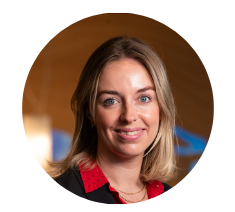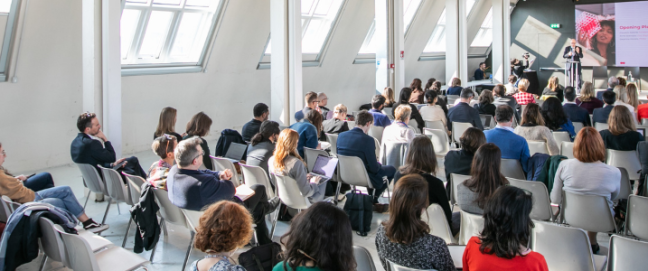The United Nations Conference on Trade and Development (UNCTD) at COP28 estimated that $500 billion is needed in developing countries in 2025 under the new finance goal to support climate action. UNCTD estimates this should then be scaled up to $1.55 trillion by 2030.
Panellists dove into questions addressing the unique role philanthropy can play alongside civil society and government to invest in technologies and solutions to combat global warming and the disproportionate effects it has on the Global South.
Moderated by Digital Editor Charlotte Kilpatrick, the speakers were:
- Elise Larkin: Director, Global Economic Recovery, The Rockefeller Foundation
- Maryati Abdullah: Program Officer, Natural Resource and Climate Change, The Ford Foundation
- Paula Ellinger: Director for Climate Action, Fundación Avina
- Kevin Tan: Founder and CEO, Tri-Sector Associates
A few highlights from the event
 Elise: We announced last September that The Rockefeller Foundation are going to pivot 75 per cent of our programming over the next 5 years to climate action and climate change focused programming. We’re going to be spending about $1 billion over that time period. Lots of people like me who looked at the foundation from the outside might have assumed that given our quite recognisable brand and our involvement in things like the Bridgetown Initiative we were already doing lots on climate, but actually it was only about 25 per cent of our programming in the last five years. So this is a really big shift for us.
Elise: We announced last September that The Rockefeller Foundation are going to pivot 75 per cent of our programming over the next 5 years to climate action and climate change focused programming. We’re going to be spending about $1 billion over that time period. Lots of people like me who looked at the foundation from the outside might have assumed that given our quite recognisable brand and our involvement in things like the Bridgetown Initiative we were already doing lots on climate, but actually it was only about 25 per cent of our programming in the last five years. So this is a really big shift for us.
Alongside that, one of the things that we felt that [climate finance] needs to mean is that we wanted our operations and the way that we run the foundation, to be aligned with the same climate goals that we’re trying to finance through our grantmaking. In 2020, we divested our endowment from fossil fuels – the largest foundation to do so at that time – and we’re also aiming for net-zero in terms of our operations by 2050. It was important to us to set that target at the same time as we announced our climate strategy.
 Maryati: Through climate, The Ford Foundation aligns with our broader mission of advancing social justice, equity and human dignity. We integrate… climate finance into our grantmaking strategy, and also collaborate with diverse stakeholders. The foundation contributes to building for a sustainable and resilient future for all. Our grantmaking and mission investments are run by our headquarters in New York, but we have started the programme of Natural Resources and Climate Change in the last five years.
Maryati: Through climate, The Ford Foundation aligns with our broader mission of advancing social justice, equity and human dignity. We integrate… climate finance into our grantmaking strategy, and also collaborate with diverse stakeholders. The foundation contributes to building for a sustainable and resilient future for all. Our grantmaking and mission investments are run by our headquarters in New York, but we have started the programme of Natural Resources and Climate Change in the last five years.
We have increasingly recognised the intersection of climate change with other areas like inequity, poverty and injustice so in climate finance, sustainable finance, we also have included gender equity, disability and how to strengthen the resilience of civil society including Indigenous people and local community alike.
In terms of just climate justice, we look at forests, energy transition – including critical mineral stores – and seven out of eleven regional offices are looking at these, from Indonesia, South Africa, the Indian region, Brazil, Mexico and New York.
 Paula: Investing and funding climate is not as simple and obvious as it may look like. Fundacion Avina we started working and funding climate 20 years ago, mainly focused on the Amazon as one of the most important contributions of Latin America to the fight against climate change. We also worked strongly on global climate governance on how to strengthen cooperation for it.
Paula: Investing and funding climate is not as simple and obvious as it may look like. Fundacion Avina we started working and funding climate 20 years ago, mainly focused on the Amazon as one of the most important contributions of Latin America to the fight against climate change. We also worked strongly on global climate governance on how to strengthen cooperation for it.
We continued doing that, which is having programmes which are, at its core, focused on climate. These past years, we have also been focused on how we strengthen the climate lens across all of our portfolio. I think this is especially fascinating because for humanity to be able to respond to the climate crisis we need responses which are at an all-systems level. It’s not only by niche investments.
 Kevin: One of the big challenges that philanthropy faces is that actually we’re the smallest players in the room. If you zoom out and look at philanthropy vs. government, around the world it’s something like a 1:26 ratio in some places. So for every year a government funds something, the biggest philanthropic fund can do so for about 2 weeks. So the challenge is how do you leverage that 2 weeks of money to affect the one year? And so some methods that have come up include blended finance – can we use the risk-taking ability of philanthropy to try to take some of the risk off the table, or enhance the returns, such that the private sector and government can also participate?
Kevin: One of the big challenges that philanthropy faces is that actually we’re the smallest players in the room. If you zoom out and look at philanthropy vs. government, around the world it’s something like a 1:26 ratio in some places. So for every year a government funds something, the biggest philanthropic fund can do so for about 2 weeks. So the challenge is how do you leverage that 2 weeks of money to affect the one year? And so some methods that have come up include blended finance – can we use the risk-taking ability of philanthropy to try to take some of the risk off the table, or enhance the returns, such that the private sector and government can also participate?
The second thing we’ve had to do is try and join some of the dots around issue areas; climate can sometimes seem like a niche issue. That works both ways. For example in Singapore every year we have a big haze issue, with a lot of smog. The downstream health impact of climate change is huge. Yet somehow the story around the healthcare costs doesn’t feature in the climate side of the equation, and vice versa. So we help to join those dots.
You can watch the full video here:
Amy McGoldrick is the Head of Marketing, Advertising and Events at Alliance magazine






Comments (0)
Uno de los grandes desafios de hoy en dia es como hacer frente al cambio climatico en adaptacion y mitigacion , como consegui la colaboracion del los Estados y las Empresas , el teme me parec muy importante